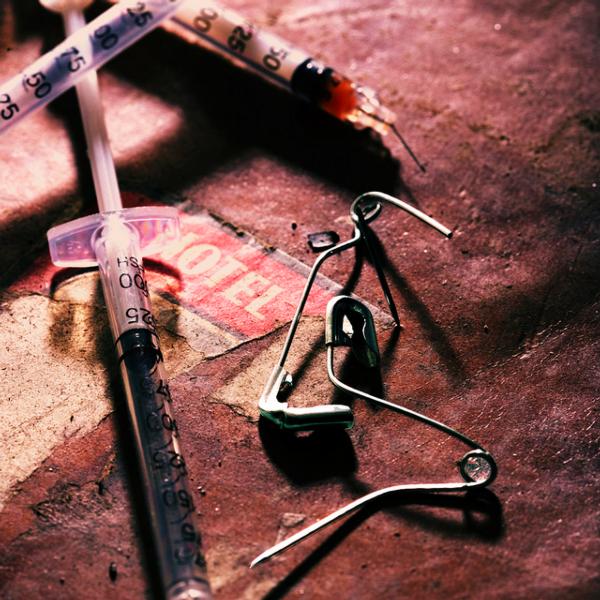
The epidemic is on the rise. Whether you decide to turn your head, remain naïve or just simply choose not to listen, the cry for help is noticeably at hand.
Get The Latest News!
Don't miss our top stories and need-to-know news everyday in your inbox.
Far too many young people in our community are falling into the trap, leaving children without a mother or father and giving up a life of hope to an infectious addiction, Heroin. According to drugabuse.gov, 4.2 million Americans ages 12 or older had used heroin at least once in 2011, and the numbers have only been rising since.
“There are certain areas in the U.S. that heroin use is on the rise, with St. Louis being one of them,” said Kathy Wickenhauser, Outreach Coordinator for Gateway Foundation Alcohol and Drug Treatment Center. “St. Louis is the Midwestern transportation hub and distribution center for illegal drugs due to its geographical location and multiple faceted transportation infrastructures. Thus making heroin easily accessible to the St. Louis area.”
According to recovergateway.org, the number of Americans using heroin has increased 75% in the past 5 years. We all hear about it. It is a repetitive and common subject in conversation, gossip, news and even the police blotter. But what is Heroin, really?
To many people in this community, Heroin is the devil, a murderer, a plague, a parasite, the silent serial killer, a stealer of souls, or simply the end of everything.
“Heroin is a substance that makes you compromise morals, ruin relationships and devalue your own self-worth,” said Amanda Phelps, a psychiatric therapist on the locked mental health unit at Christian Hospital in St. Louis. “No passion, no dreams, no future.”
One thing we do know is that heroin is REAL. Heroin is a manufactured drug that is synthesized from morphine. Morphine is naturally found in Asian opium poppy plant.
 Heroin normally comes in a white or brown powder form. It can also appear as a sticky black substance, called black tar heroin. Heroin can be injected, sniffed or smoked, all three methods route the drug directly to the opioid receptors of the brain and is converted back to morphine, according to drugabuse.com. These opioid receptors are found in many parts of the brain that alter the perception of pain. The receptors are also located in the brain stem, which controls unconscious processes critical for survival such as respiration and blood pressure.
Heroin normally comes in a white or brown powder form. It can also appear as a sticky black substance, called black tar heroin. Heroin can be injected, sniffed or smoked, all three methods route the drug directly to the opioid receptors of the brain and is converted back to morphine, according to drugabuse.com. These opioid receptors are found in many parts of the brain that alter the perception of pain. The receptors are also located in the brain stem, which controls unconscious processes critical for survival such as respiration and blood pressure.
Heroin gives the user a sense of euphoria and a pain-free sensation. People describe the sensation of being high on heroin as feeling safe and warm. It is a calm, relaxing and a dream-like state.
“It feels like being wrapped in a warm blanket that makes you feel like nothing is wrong in your life,” said Matt, a recovering heroin addict from Alton. “You get what is called ‘the nods,’ which makes you drift in and out of consciousness. I called it ‘time traveling’ because I would just wake up and not know what time it was, or if it was even day or night.”
Young adults in troubled positions, depressed or feeling extreme pain, are generally the ones that turn to Heroin for relief, both physical and mental.
“I started using heroin the day I walked down stairs and found my father dead from cancer in my dining room,” said Matt. “I wanted anything to take away that pain. My brother was already using and said it would take care of any kind of pain, both physical and emotional. Which at that time, it did for a very brief period.”
Studies report that many individuals turn to heroin after abusing prescription opioid pain medication such as Oxycontin and Vicodin. If abused, prescription pain pills can have similar effects as heroin. Many users become dependent on the pills and find it easier and cheaper to turn to heroin. In several surveys, it was found that nearly half of those who inject heroin, abused prescription pain medicine before turning to heroin.
 “I was already addicted to pain medication, which got expensive and hard to come by due to the laws of supply and demand,” said Matt. “Almost all heroin users I’ve met started the same way. Heroin is stronger and cheaper, it’s simple economics.”
“I was already addicted to pain medication, which got expensive and hard to come by due to the laws of supply and demand,” said Matt. “Almost all heroin users I’ve met started the same way. Heroin is stronger and cheaper, it’s simple economics.”
The Gateway Foundation declared that for the first time in history, the number of admissions for opiate dependency exceeded the number of admissions for alcohol dependency.
“You just didn’t hear about heroin really when we were in school,” said Cheryl Thompson of Alton, someone that has been effected by the heroin epidemic in many ways for several years. “You may have heard about it, but everyone basically knew not to touch it.”
As dependency continues, the user’s emotional and physical health declines dramatically. People on heroin lose interest in things they enjoyed doing and find it hard to make decisions and handle any kind of stress. They may begin to pull themselves away and become depressed.
“The drug totally takes over your life and ruins relationships with the ones you love and you find yourself surrounded by other addicts because they won’t judge you for the poor decisions you make,” said Matt. “After a while, you just get tired of the same routine of waking up and trying to find a way to get high. It lasts 4-6 hours before you need to inject more dope so it takes up to 100% of your time.”
The ultimate sacrifice a heroin user could face is death. Repeated injections can cause collapsed veins and lead to infections. Pneumonia, Arthritis and Tuberculosis are just a few of many conditions a user can obtain as a result of long-term use. HIV is often a threat when injecting, the reuse of a needle makes HIV a very high risk. Heroin users should expect a weakened immune system, breathing problems, insomnia, dental issues and much more.
It is highly important to know the signs of a heroin user. Catching on to the situation quick will help the user in the long run. The sooner someone gets help, the chances of them making a successful recovery is higher.
“My son went an entire year using heroin before I caught on to what was really happening,” said Thompson. “I looked at him real close and asked what was wrong with him and the look in his face was someone else, it was not my son.”
When high on heroin, pupils are constricted, the brain becomes ‘cloudy’ and difficulty breathing may occur, with a shortness of breath. A user may slur their speech or not even make sense out of their jumbled words. Many get an uncontrollable feeling of itchiness and cannot refrain from scratching.
“The signs are totally different than any other drug, I’ve never seen anything like it,” said Thompson. “Had I known what to look for, maybe I could’ve done something sooner and maybe Josh wouldn’t have died.”
Josh, who Thompson considered one of her own, was her son’s best friend that overdosed on heroin in September 2013.
According to recovergateway.org, medical examiners reported that heroin is one of the most frequent outcome of deaths caused by drug abuse. In other words, Heroin kills people more than most (if not all) drugs out there.
“Three of my childhood friends have died from heroin. They weren’t even real users either, they just experimented occasionally and it still killed them,” said Matt. “Heroin is not for weekend warriors, it’s for the real hardcore addicts that can handle the bucking bronco long enough to stay alive and make it out unscathed.”
 One of the main issues with fighting off heroin is that it is highly addictive. Once someone is using heroin, it does not take long for their bodies to require more and more dosage to obtain the desired high, forming a greater tolerance. The body quickly becomes physically dependent on the drug and the vicious battle with heroin addiction arises.
One of the main issues with fighting off heroin is that it is highly addictive. Once someone is using heroin, it does not take long for their bodies to require more and more dosage to obtain the desired high, forming a greater tolerance. The body quickly becomes physically dependent on the drug and the vicious battle with heroin addiction arises.
According to drugabuse.com, roughly 23% of individuals who use heroin, become dependent on it. That is an alarming percentage, considering becoming dependent on Heroin basically means your body needs the drug to feel normal.
“I was probably already addicted before trying it, due to liking Oxycontin, but the opiate strength is what causes the extreme physical withdrawals from heroine,” said Ryan, a former heroin user from Chicago. “When stopping and going through withdrawals is when most people first realize they are truly addicted.”
The withdrawal symptoms are so unbearable and the user knows what to expect when the drug wears off, but there is generally other underlying causes why people continue to use.
“I continued to use heroin because I was afraid to quit. I was afraid of being sick, afraid of dealing with the day to day problems we all encounter and afraid of the boredom,” said Matt. “They say an idle mind is the devil’s playground and that is so true in the life of an addict. Plus after a while, it’s what you know and all you know.”
Withdrawal symptoms are the number one reason why this particular drug habit is so difficult to quit. Even a short few hours after the last use, symptoms can begin to occur. Symptoms include vomiting, diarrhea, abrupt motions such as kicking, cold flashes, slowed breathing, muscle and bone pain, drowsiness, insomnia, etc.
“Hot and cold back and forth, sweating, distinct smell of sweat from opiate detox, chills, goose bumps, no appetite, nausea, stomach cramps, headache, muscle spasms, muscle cramps, diarrhea, throwing up, severe depression, restlessness, the list goes on,” said Ryan.
Major withdrawal symptoms top out between 48 and 72 hours after the last hit and can last days, weeks, and even months.
“To me, detoxing from heroin is comparable to the worst flu you will ever have in your life, with severe depression added due to an almost ecstasy-like effect on the brain,” said Ryan. “You also are not numb at that point anymore and are fully aware of how bad you've been screwing up.”
It is hard to watch someone struggle with this life altering issue, especially when you feel like you’ve done everything already and exhausted all options. Many find it frustrating to watch someone they love deteriorate before their eyes, feeling guilty and helpless.
“It feels like you’re stuck behind a glass wall, looking in on your family and watching them kill themselves and not be able to get in the room with them to help, “ said Amanda Place, whose fiancé left her with two little girls to raise on her own. “I wish every day that I would have had more information about heroin so I would have known he had never really stopped using. I wish I had stayed awake that night instead of going to bed angry at him. I wish I would have just called an ambulance, his mom, anyone, when I found him nodded out. There is so many things I wish I could’ve done. Anything was better than doing nothing.”
Unfortunately, a heroin user cannot be forced into getting treatment or admit into a rehab facility. The user must truly want to turn their life around themselves.
“You have to want it,” said Thompson. “You have to do the 12 steps, you have to go to the meetings and change significant influences in your life to completely transform. You will not make it if you do not want it.”
Dealing with someone you love that is on heroin can be difficult and get very complicated. It is important to be supportive. Do not be ashamed, talk about it with others. You may find that people you know are going through the same thing and have leads to a better future. If you do not address the issue, the outcome can become fatal faster than you think.
 “Never give up hope, be tough and be strong, because they can’t,” said Laura Bonds, who has lost several people close to her as result to heroin use. “Join a support group for advice on how to deal with emotions and get information on treatment center locations. Just do not give up on them.”
“Never give up hope, be tough and be strong, because they can’t,” said Laura Bonds, who has lost several people close to her as result to heroin use. “Join a support group for advice on how to deal with emotions and get information on treatment center locations. Just do not give up on them.”
Another mistake people make when dealing with an addict is becoming their enabler. As much as you try to help that person, you may be making matters worse. You could be an enabler if you allow a user to live in your house for free. Not turning them in to the police for stealing things to pawn off for more drugs can make you an enabler. It is a difficult line to walk.
“It is so hard for a mother, I had to tell my son he was not allowed to live in my house anymore,” said Thompson. “I told him that I cannot come home and find him dead on my floor.”
Thompson added that she risked him hating her forever by making these types of decisions while transitioning from the enabling stand point.
“I knew I was jeopardizing my relationship with my son,” said Thompson. “He may hate me and never want to talk to me again, but at least he would still be alive.”
There are several options for users to turn to for help, but be prepared for the tedious task that may come about.
“I called and called and called around for days getting the run-around and finding no path,” said Thompson. “Everyone told me that my son had to be clean of heroin to be able to be admitted into rehab, but that’s why he was going in the first place. It just did not make sense to me.”
The detoxification process is so severe and dangerous, it becomes a liability for an organization and therefore they may not accept people that have not detoxed the drug from their system. The facility must be staffed with proper medical professionals to take on a client detoxing from opiates.
“The withdrawal from opiates could potentially be physically dangerous, but people will not die from withdrawal,” said Susan Tayler, Director of Adult Substance Abuse Services and Chestnut Health Systems. “Residential facilities may not take clients who are positive for opiates if they do not have the medical staff to monitor for withdrawal. Generally, clients must detox themselves or go to a detox facility prior to residential treatment.”
To reduce the risks of health complications and relapse, medical experts recommend seeking detox services rather than attempting to quit ‘cold turkey.’
Chestnut rehabilitation facilities, among others, offer outpatient services for clients in active addiction, which is when the need help the most.
Another issue is that many users do not have the funds or medical insurance to afford to go to rehab. Facilities such as Chestnut Health Systems can provide both residential and outpatient services on a sliding scale based on a person’s income. The help is there, it just going to take some digging.
There has to be a way to get something rolling so that there are more options for those in dire need. As a community, what can we do to help fight this heroin war that is taking our loved ones?
Actions must be demanded.
“Increasing education and awareness is the first step,” said Edward Bonds, older brother of Aaron Bonds, a former U.S. Marine that overdosed on heroin in Alton in June of 2014. “Insurance companies need to increase the medical coverage to fully treat the disease. The government also needs to increase funding for treatment facilities. Allowing the sales of needles at local pharmacies should be by prescription only. Harsher prison sentences should be applied to dealers of this deadly drug.”
For more information on Walking for Wellness: Stop Heroin, visit or http://www.stopheroin.org or https://www.facebook.com/stopheroin
Follow Riverbender.com for future pieces to the Heroin Epidemic Series.
Story By: Brittany J. Kohler [ brittany@riverbender.com ]
All photos from https://www.flickr.com/creativecommons/

More like this:

